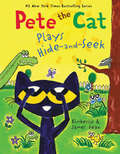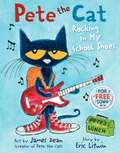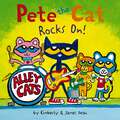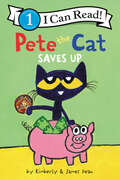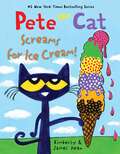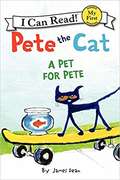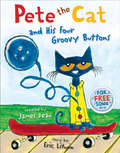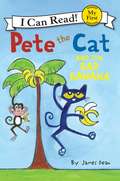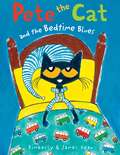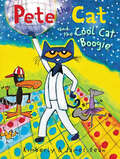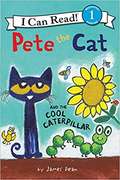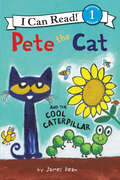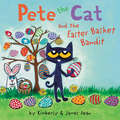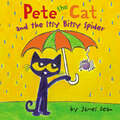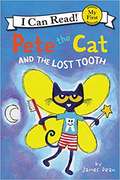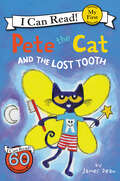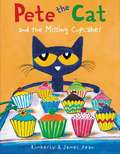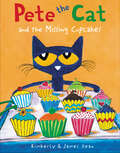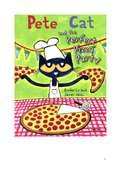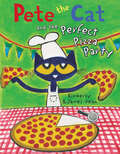- Table View
- List View
Pete the Cat Parents' Day Surprise (Pete the Cat)
by Kimberly Dean James DeanBased on the Amazon Original series that was inspired by the classic bestselling picture book series! Pete the Cat and his friends are all excited about Parents’ Day—all except for Gustavo. Turns out his mom can’t make it to Parents’ Day because she’s stationed far away. But that gives Pete and his pals an idea.Can the gang help Gus show his mother how important she is to him, no matter the distance? Kids will love this brand-new Pete the Cat picture book that retells groovy moments from the popular show!
Pete the Cat Pete at the Beach (Pete The Cat)
by James DeanPete the Cat is one groovy cat at finding shells and building sand castles at the beach. But when it gets too hot, there’s only one way to cool off—jump into the ocean! Except Pete might be a scaredy-cat when it comes to the water. Pete the Cat: Pete at the Beach is a My First I Can Read book, which means it’s perfect for shared reading with a child.
Pete the Cat Plays Hide-and-Seek (Pete the Cat)
by Kimberly Dean James DeanPete the Cat loves to play hide-and-seek! When his friends hide, Pete covers his eyes and counts to 10. He opens them and just knows he will find them soon.But finding his friends may be harder than Pete thought. Are they behind a tree or on a bus? Or will Pete give up?Find out how Pete learns to chill out in this cool story full of surprises at every peek!From the authors of the #1 New York Times bestselling Pete the Cat series, James and Kimberly Dean, this picture book is reminiscent of Pete favorites like Magic Sunglasses and perfect for fans of Grumpy Monkey by Suzanne Lang.Don't miss Pete's other adventures, including Pete the Cat: I Love My White Shoes, Pete the Cat: Rocking in My School Shoes, Pete the Cat and His Four Groovy Buttons, Pete the Cat Saves Christmas, Pete the Cat and His Magic Sunglasses, Pete the Cat and the Bedtime Blues, Pete the Cat and the New Guy, Pete the Cat and the Cool Cat Boogie, Pete the Cat and the Missing Cupcakes, and Pete the Cat and the Perfect Pizza Party, Pete the Cat: Crayons Rock!, and Pete the Cat’s Groovy Imagination.
Pete the Cat Rocking in My School Shoes: A Back To School Book For Kids (Pete The Cat Ser.)
by Eric LitwinPete the cat wears his school shoes while visiting the library, the lunchroom, the playground, and more while singing his special song.
Pete the Cat Rocks On! (Pete the Cat)
by Kimberly Dean James DeanRock on with Pete the Cat in this groovy storybook about keeping calm and rocking on by New York Times bestselling author-illustrator team Kimberly and James Dean. Includes over thirty stickers!Pete the Cat can’t wait to rock out at the Alley Cats concert! But when the band never comes onstage, it’s up to Pete to find them. Will Pete have the right instruments to help the Alley Cats save the show? Find out in this rockin’ story full of problem-solving and friendship! Includes over thirty awesome stickers.
Pete the Cat Saves Christmas (Pete the Cat)
by Kimberly Dean Eric LitwinA New York Times bestselling Pete the Cat holiday picture book!Spend the holidays with your favorite blue cat! In this rockin' spin on the traditional tale The Night Before Christmas, Pete the Cat proves that giving your all in the spirit of Christmas is the totally groovy thing to do.The fun never stops—don’t miss Pete’s other spin on a holiday classic, Pete the Cat’s 12 Groovy Days of Christmas.Don't miss Pete's other adventures, including Pete the Cat: I Love My White Shoes, Pete the Cat: Rocking in My School Shoes, Pete the Cat and His Four Groovy Buttons, Pete the Cat and His Magic Sunglasses, Pete the Cat and the Bedtime Blues, Pete the Cat and the New Guy, Pete the Cat and the Cool Cat Boogie, Pete the Cat and the Missing Cupcakes, and Pete the Cat and the Perfect Pizza Party.
Pete the Cat Saves Up (I Can Read Level 1)
by Kimberly Dean James DeanPete the Cat earns and saves money to buy a supercool toy in this Level 1 I Can Read from New York Times bestselling creators Kimberly and James Dean.Pete the Cat wants a supercool Sharkbot toy, but he doesn’t have enough money in his piggy bank. He takes on odd jobs, from shoveling snow to selling lemonade and more, and saves every penny. How long will it take for him to earn enough money to buy the toy? Find out in this Level 1 I Can Read book complete with original illustrations from the creators of Pete the Cat, Kimberly and James Dean. Pete the Cat Saves Up is perfect for children learning to sound out words and sentences. Whether shared at home or in a classroom, the short sentences, familiar words, and simple concepts of Level One books support success for children eager to start reading on their own.
Pete the Cat Screams for Ice Cream! (Pete the Cat)
by Kimberly Dean James DeanI scream! You scream! Pete screams for ice cream! <P><P> The Just Chillin’ ice cream truck is coming today and Pete the Cat can't wait. He runs as fast as he can to find the truck. It's getting late, but his friends need his help. <P><P> Will Pete take a little time out of his day to help his friends? <P><P> Follow Pete the Cat as he learns that it's always cool to be kind. <P><P> From the authors of the #1 New York Times bestselling Pete the Cat series, James and Kimberly Dean, this picture book is reminiscent of Pete favorites like Magic Sunglasses and perfect for fans of Grumpy Monkey by Suzanne Lang. <P><P><i>Advisory: Bookshare has learned that this book offers only partial accessibility. We have kept it in the collection because it is useful for some of our members. Benetech is actively working on projects to improve accessibility issues such as these.</i> <p> <b>New York Times Bestseller</b>
Pete the Cat a Pet for Pete (My First I Can Read)
by James Dean<p>Pete the Cat is back with another groovy I Can Read adventure from New York Times bestselling author and artist James Dean. <p>Pete the Cat can’t wait to get a new pet! He gets a goldfish he names Goldie. Pete paints a cool painting of Goldie and now everyone wants a piece of it! But Pete doesn't have enough time to make one for everyone. Will Pete find a way to have fun painting Goldie and have time to finish his homework? <p>Pete the Cat: A Pet for Pete is a My First I Can Read Book, which means it's perfect for shared reading with a child.</p>
Pete the Cat and His Four Groovy Buttons (Pete the Cat)
by Kimberly Dean Eric LitwinAn award-winning and bestselling Pete the Cat hardcover picture book! Count down with Pete in this rocking story that makes counting fun! Pete the Cat is wearing his favorite shirt—the one with the four totally groovy buttons.But when one falls off, does Pete cry? Goodness, no! He just keeps on singing his song—after all, what could be groovier than three groovy buttons? This book is a winner of the Theodor Seuss Geisel Honor Award. Plus the fun never stops—download the free groovin’ song!Don't miss Pete's other adventures, including Pete the Cat: I Love My White Shoes, Pete the Cat: Rocking in My School Shoes, Pete the Cat Saves Christmas, Pete the Cat and His Magic Sunglasses, Pete the Cat and the Bedtime Blues, Pete the Cat and the New Guy, Pete the Cat and the Cool Cat Boogie, Pete the Cat and the Missing Cupcakes, Pete the Cat and the Perfect Pizza Party, and Pete the Cat: Crayons Rock!
Pete the Cat and His Magic Sunglasses (Pete the Cat)
by Kimberly Dean James DeanFrom the bestselling Pete the Cat series, Pete's magic sunglasses help him turn his mood from grumpy to awesome!Pete the Cat wakes up feeling grumpy—nothing seems to be going his way. But with the help of some magic sunglasses, Pete learns that a good mood has been inside him all along.Fans of Pete the Cat will love watching him take his positive outlook and transform a grumpy day into an awesome day!The fun never stops—download the free groovin’ song. Time for magic fun in the sun!Don't miss Pete's other adventures, including Pete the Cat: I Love My White Shoes, Pete the Cat: Rocking in My School Shoes, Pete the Cat and His Four Groovy Buttons, Pete the Cat Saves Christmas, Pete the Cat and the Bedtime Blues, Pete the Cat and the New Guy, Pete the Cat and the Cool Cat Boogie, Pete the Cat and the Missing Cupcakes, Pete the Cat and the Perfect Pizza Party, and Pete the Cat: Crayons Rock!
Pete the Cat and the Bad Banana (My First I Can Read)
by Kimberly Dean James DeanNew York Times bestselling author and artist James Dean brings readers along for a hilarious ride with Pete the Cat!Pete the Cat bites into a bad banana and decides that he never, ever wants to eat another banana again. But Pete really likes bananas! Will a rotten bite ruin Pete's love for this tasty fruit?Pete the Cat and the Bad Banana is a My First I Can Read book, which means it's perfect for shared reading with a child.
Pete the Cat and the Bedtime Blues (Pete the Cat)
by Kimberly Dean James DeanBedtime is always fun with this hilarious bedtime story from Kimberly and James Dean’s New York Times bestselling Pete the Cat series.Pete the Cat and his friends are having so much fun playing and surfing in the sun, they don't want the day to end. Pete has an idea—how about a sleepover? Groovy!As the night gets later, it's time for bed. This cool cat needs to catch some ZZZs, but Pete's friends aren't ready to go to sleep just yet. Then Pete has another idea—a bedtime story! But will it work?The musical text and comforting repetition are perfect for nighttime read-alouds. Kids will be eager to snuggle under the covers and drift off to sleep to this bedtime story along with Pete’s really cool friends.Don't miss Pete's other adventures, including Pete the Cat: I Love My White Shoes, Pete the Cat: Rocking in My School Shoes, Pete the Cat and His Four Groovy Buttons, Pete the Cat Saves Christmas, Pete the Cat and His Magic Sunglasses, Pete the Cat and the New Guy, Pete the Cat and the Cool Cat Boogie, Pete the Cat and the Missing Cupcakes, Pete the Cat and the Perfect Pizza Party, and Pete the Cat: Crayons Rock!
Pete the Cat and the Cool Cat Boogie (Pete the Cat)
by Kimberly Dean James DeanPut on your dancing shoes—Pete is ready to boogie!Pete is learning a new dance—the Cool Cat Boogie! When he hears a groovy beat, he’s full of happy in his feet. But when Grumpy Toad tells him, “Pete, you dance all wrong!” Pete is determined to become a better dancer.With the help of his friends and some wise words from Owl, Pete learns that he’s his grooviest when he’s being himself. Includes step-by-step dance moves so readers can dance along with Pete!Join Pete the Cat in this groovy story from New York Times bestselling author-illustrator team James and Kimberly Dean! Don't miss Pete's other adventures, including Pete the Cat: I Love My White Shoes, Pete the Cat: Rocking in My School Shoes, Pete the Cat and His Four Groovy Buttons, Pete the Cat Saves Christmas, Pete the Cat and His Magic Sunglasses, Pete the Cat and the Bedtime Blues, Pete the Cat and the New Guy, Pete the Cat and the Missing Cupcakes, Pete the Cat and the Perfect Pizza Party, and Pete the Cat: Crayons Rock!
Pete the Cat and the Cool Caterpillar (I Can Read Level 1)
by James Dean<p>Pete the Cat meets a super-cool caterpillar in the first Pete the Cat Level 1 I Can Read tale from New York Times bestselling author-illustrator James Dean! <p>Pete thinks he found a new best friend. But when his caterpillar goes missing, Pete has to find out what happened to his new friend. Pete is in for one wild surprise at the end! <p>Pete the Cat and the Cool Caterpillar is a Level I Can Read book, complete with original illustrations from the creator of Pete the Cat, James Dean, and is perfect for children learning to sound out words and sentences.</p>
Pete the Cat and the Cool Caterpillar (I Can Read Level 1)
by Kimberly Dean James DeanPete the Cat meets a super-cool caterpillar in the first Pete the Cat Level 1 I Can Read tale from New York Times bestselling author-illustrator James Dean.Pete thinks he found a new best friend. But when his caterpillar goes missing, Pete has to find out what happened to his new friend. Pete is in for one wild surprise at the end!Pete the Cat and the Cool Caterpillar is a Level I Can Read book, complete with original illustrations from the creator of Pete the Cat, James Dean, and is perfect for children learning to sound out words and sentences. Whether shared at home or in a classroom, the short sentences, familiar words, and simple concepts of Level One books support success for children eager to start reading on their own.
Pete the Cat and the Easter Basket Bandit (Pete the Cat)
by Kimberly Dean James DeanPete and his friends hunt for his missing Easter basket in this storybook—complete with a fold-out poster, stickers, and cards perfect for Easter celebrations!It’s Easter morning, and Pete's Easter basket is nowhere to be found! Who could’ve taken it?Readers will love helping Pete and his friends find the Easter Basket Bandit and learn that sharing is the sweetest gift of all! Pete the Cat and the Easter Basket Bandit is a must-have gift for Easter baskets!
Pete the Cat and the Itsy Bitsy Spider (Pete the Cat)
by Kimberly Dean James DeanPete the Cat’s cool adaptation of the classic children’s song "Itsy Bitsy Spider" will have have young readers laughing and singing along.The itsy bitsy spider climbed up the water spout. Down came the rain....As the itsy bitsy spider struggles, Pete and his friends know just what to do to help out!Fans of James Dean's #1 New York Times bestselling Pete the Cat will love rocking out with Pete.
Pete the Cat and the Lost Tooth (My First I Can Read)
by James Dean<p>New York Times bestselling author and artist James Dean brings readers along for a fun and surprising adventure with Pete the Cat! <p>In Pete the Cat and the Lost Tooth, the tooth fairy asks Pete for some help. But it’s not easy being the tooth fairy for Pete when a tooth goes missing—will he be able to find the lost tooth before it’s too late? <p>Beginning readers will love Pete's adventure as the tooth fairy in this My First I Can Read story, complete with original illustrations from the creator of Pete the Cat, James Dean. My First I Can Read books are perfect for shared reading with a child.</p>
Pete the Cat and the Lost Tooth (My First I Can Read)
by Kimberly Dean James DeanNew York Times bestselling author and artist James Dean brings readers along for a fun and surprising adventure with Pete the Cat!In Pete the Cat and the Lost Tooth, the tooth fairy asks Pete for some help. But it’s not easy being the tooth fairy for Pete when a tooth goes missing—will he be able to find the lost tooth before it’s too late?Beginning readers will love Pete's adventure as the tooth fairy in this My First I Can Read story, complete with original illustrations from the creator of Pete the Cat, James Dean. My First I Can Read books are perfect for shared reading with a child.
Pete the Cat and the Missing Cupcakes (Pete The Cat)
by Kimberly Dean James DeanPete the Cat and his friend Gus bake ten delicious cupcakes for their party. But the cupcakes start to disappear one by one! Pete and his friends follow the clues to solve the mystery. They discover Grumpy Toad ate them all. Instead of staying mad, Pete decides to forgive him, teaching everyone a valuable lesson about second chances.
Pete the Cat and the Missing Cupcakes (Pete the Cat)
by Kimberly Dean James DeanFrom the bestselling Pete the Cat series, help Pete and his friends find the missing cupcakes!Pete the Cat and his friends are busy as can be baking cupcakes for a party, and Pete can’t wait to perform with his groovy band. But some of the cupcakes have gone missing! Who could have taken them?In this picture book adventure by New York Times bestselling authors James and Kimberly Dean, Pete and the gang solve the mystery of the missing cupcakes and learn that it’s cool to be kind.The Pete the Cat fun never stops—watch the groovin’ video online!Don't miss Pete's other adventures, including Pete the Cat: I Love My White Shoes, Pete the Cat: Rocking in My School Shoes, Pete the Cat and His Four Groovy Buttons, Pete the Cat Saves Christmas, Pete the Cat and His Magic Sunglasses, Pete the Cat and the Bedtime Blues, Pete the Cat and the New Guy, Pete the Cat and the Cool Cat Boogie, and Pete the Cat and the Perfect Pizza Party. <P><P><i>Advisory: Bookshare has learned that this book offers only partial accessibility. We have kept it in the collection because it is useful for some of our members. Benetech is actively working on projects to improve accessibility issues such as these.</i> (edited)
Pete the Cat and the New Guy (Pete the Cat)
by Kimberly Dean James DeanFrom Kimberly and James Dean’s bestselling Pete the Cat series comes a groovy story about new beginnings and new friends.There's a new guy in town, and Pete can't wait to meet him. After all, more friends mean more fun. When Pete finally meets Gus, he realizes they're very different from each other...and that's what makes him cool. So when Gus starts to doubt himself, it’s up to Pete to convince him that there's something everyone can do. Gus is special in his own way, just like Pete and just like you!The message of accepting others and yourself shines through and is perfect for young readers learning to navigate friendship issues. Fans of Pete the Cat will delight in the rhythmic storytelling and fun repetition throughout the book.The fun never stops—download the free groovin’ song!Don't miss Pete's other adventures, including Pete the Cat: I Love My White Shoes, Pete the Cat: Rocking in My School Shoes, Pete the Cat and His Four Groovy Buttons, Pete the Cat Saves Christmas, Pete the Cat and His Magic Sunglasses, Pete the Cat and the Bedtime Blues, Pete the Cat and the Cool Cat Boogie, Pete the Cat and the Missing Cupcakes, Pete the Cat and the Perfect Pizza Party, and Pete the Cat: Crayons Rock!
Pete the Cat and the Perfect Pizza Party (Pete The Cat)
by Kimberly and James DeanPete the Cat invites his friends to a pizza party wherein they add different toppings to their pizza.
Pete the Cat and the Perfect Pizza Party (Pete the Cat)
by Kimberly Dean James DeanA groovy New York Times bestseller!From the bestselling Pete the Cat series, it’s a groovy pizza party that you don’t want to miss!It’s a party, a party, a perfect pizza party!That’s what Pete thinks as he piles the pie high with his favorite topping—pepperoni. But then his friends come over and add their own toppings to the pizza. Will Pete’s perfect pizza be ruined? There’s only one way to find out!In this picture book full of fun alliteration and tasty foods by the New York Times bestselling team of Kimberly and James Dean, Pete and the gang learn that the best kind of pizza is one you share with your friends.Don't miss Pete's other adventures, including Pete the Cat: I Love My White Shoes, Pete the Cat: Rocking in My School Shoes, Pete the Cat and His Four Groovy Buttons, Pete the Cat Saves Christmas, Pete the Cat and His Magic Sunglasses, Pete the Cat and the Bedtime Blues, Pete the Cat and the New Guy, Pete the Cat and the Cool Cat Boogie, and Pete the Cat and the Missing Cupcakes.


